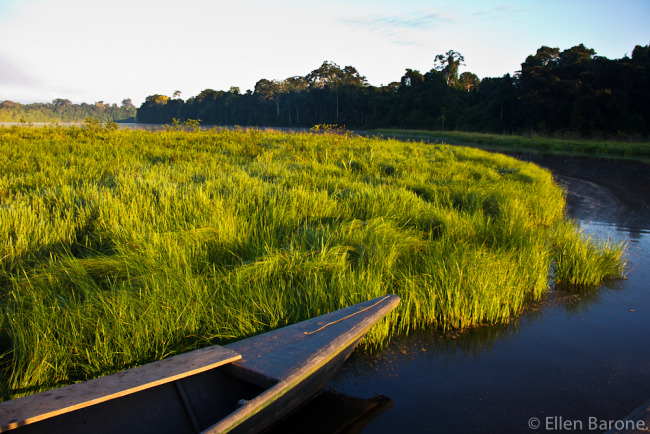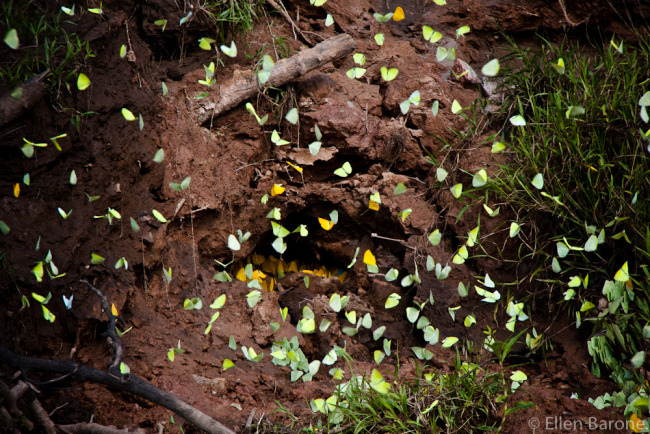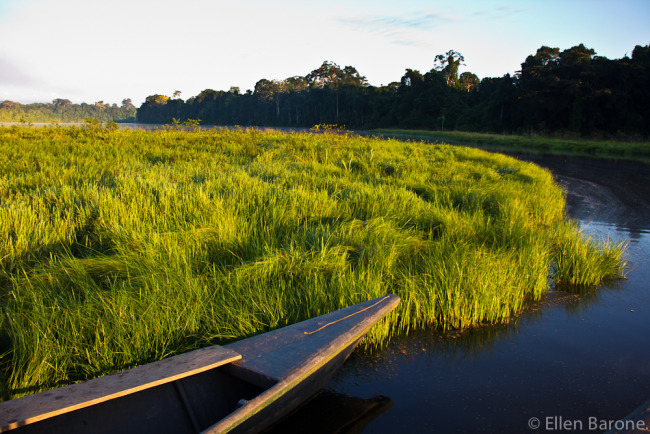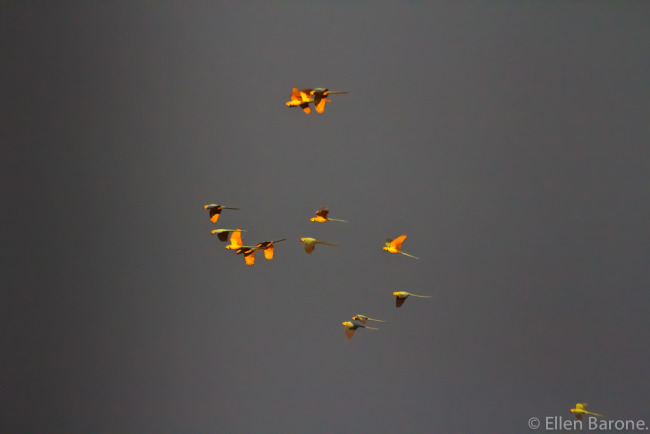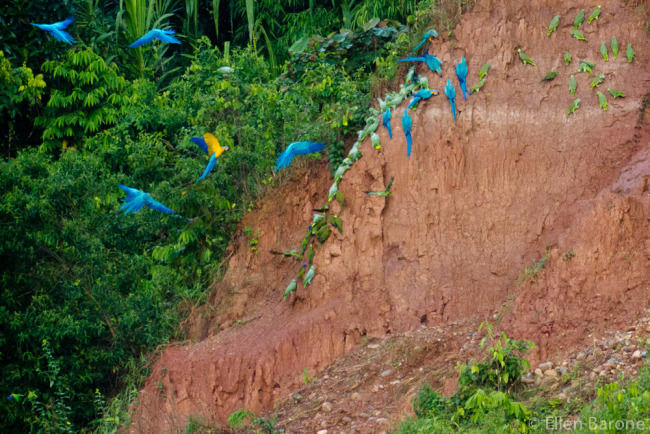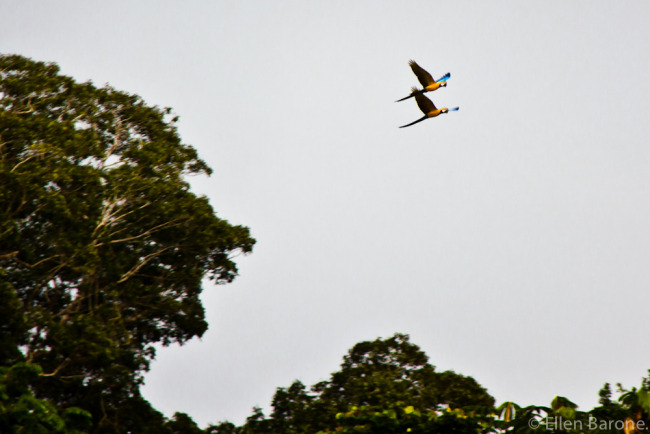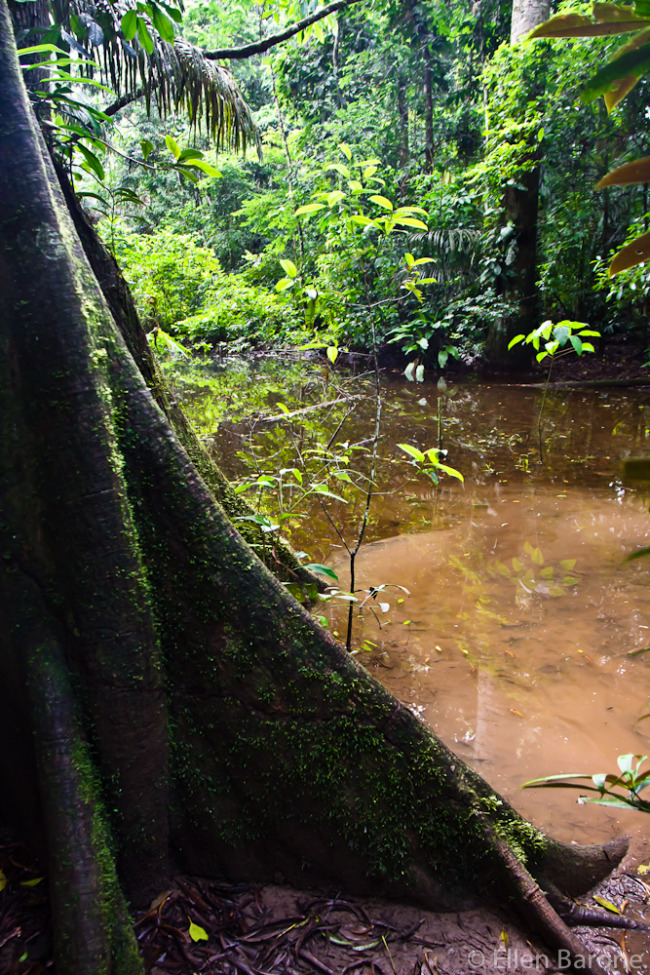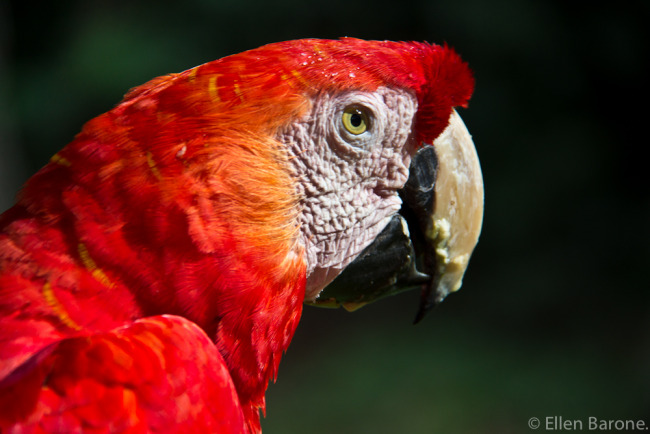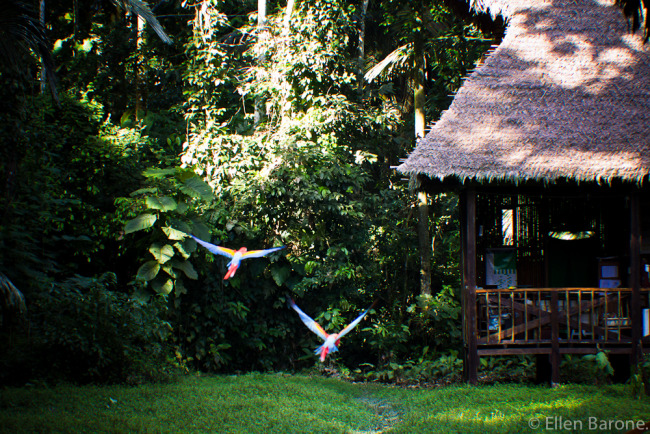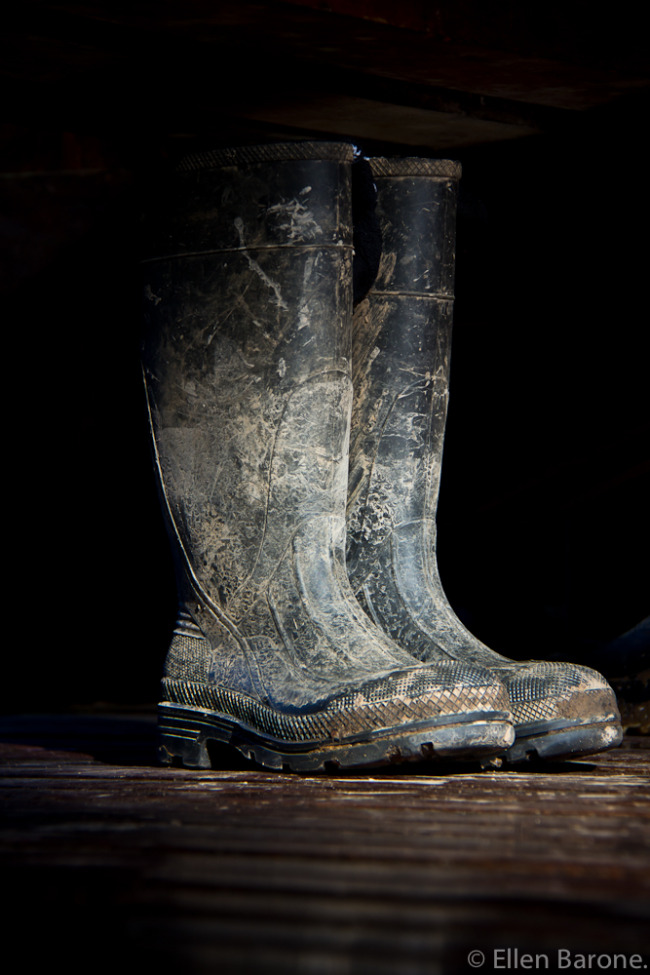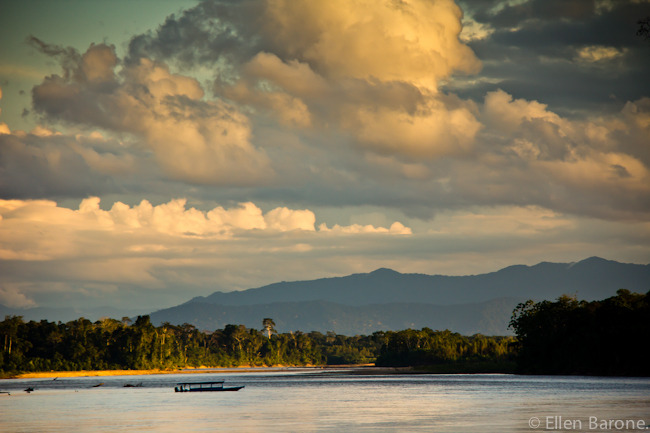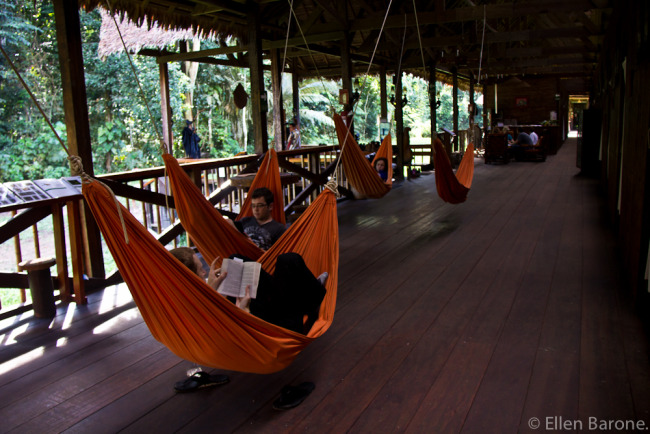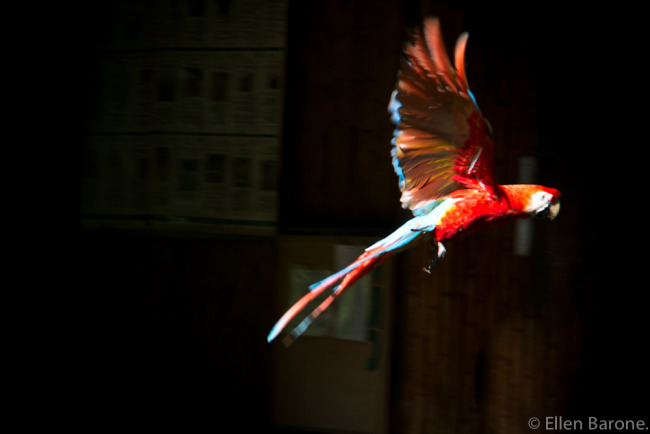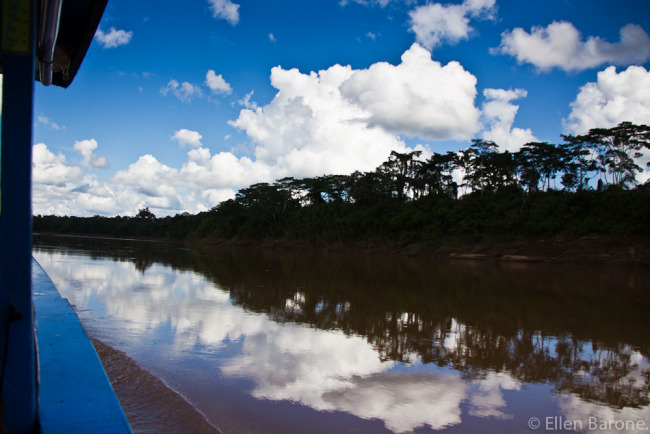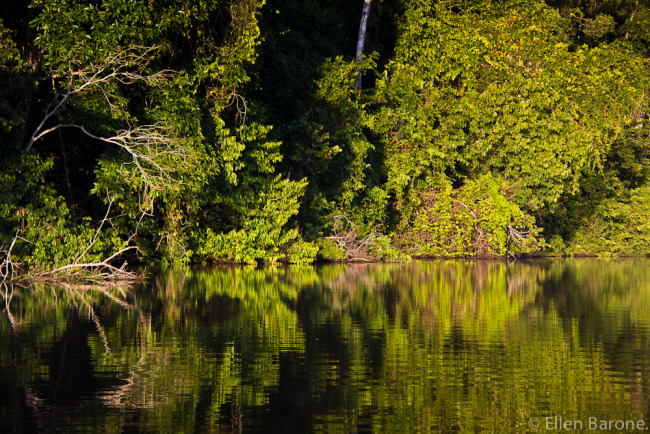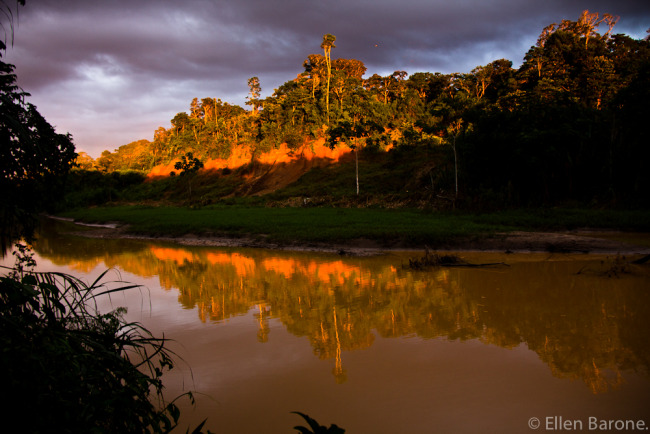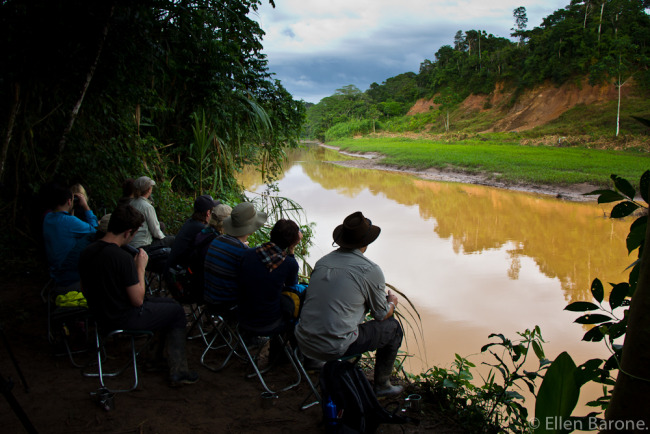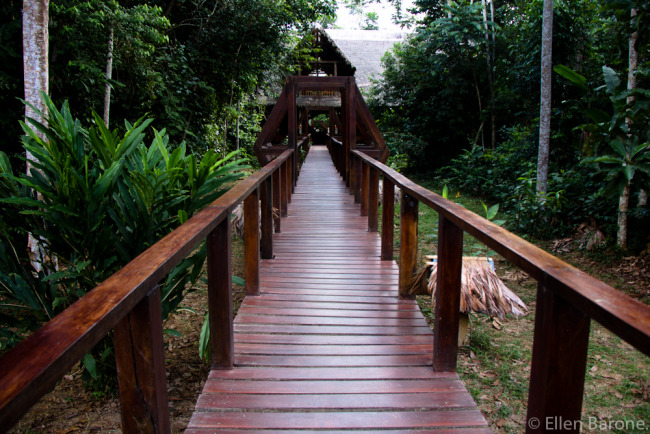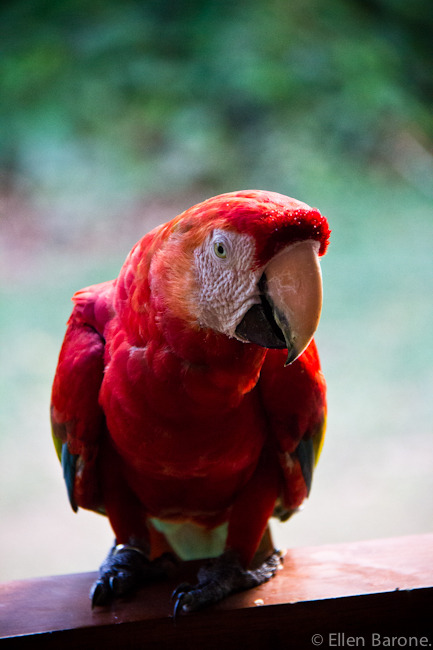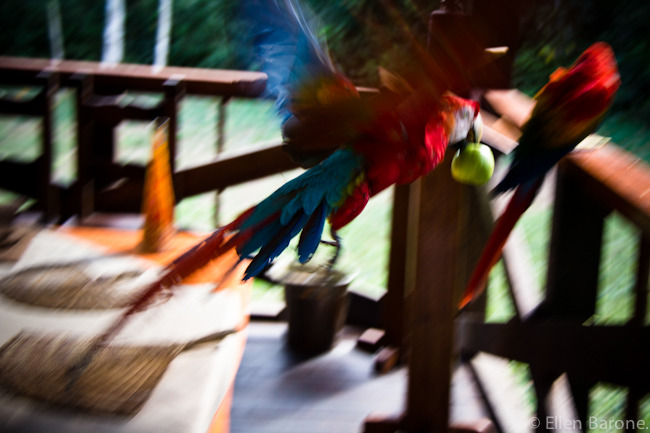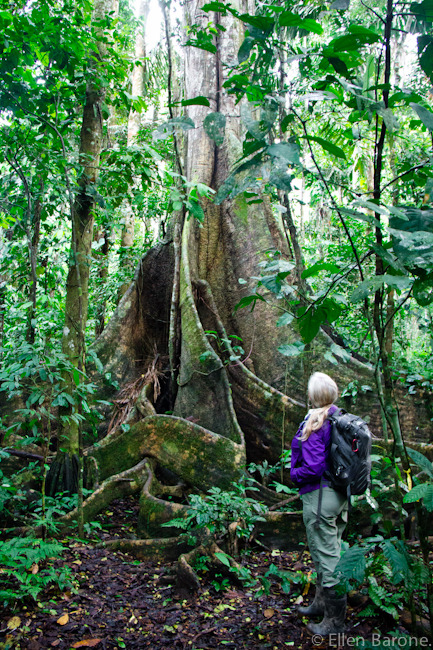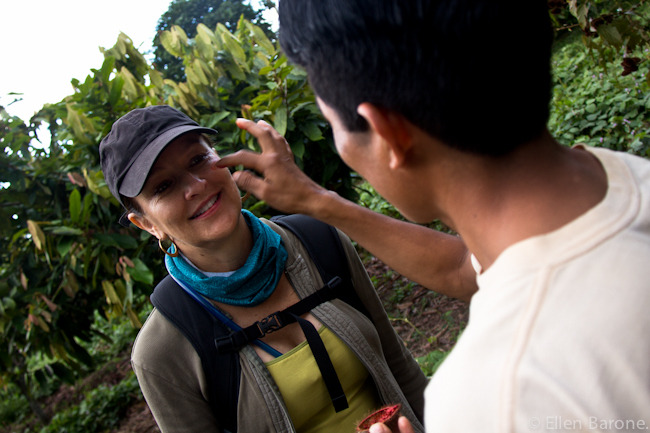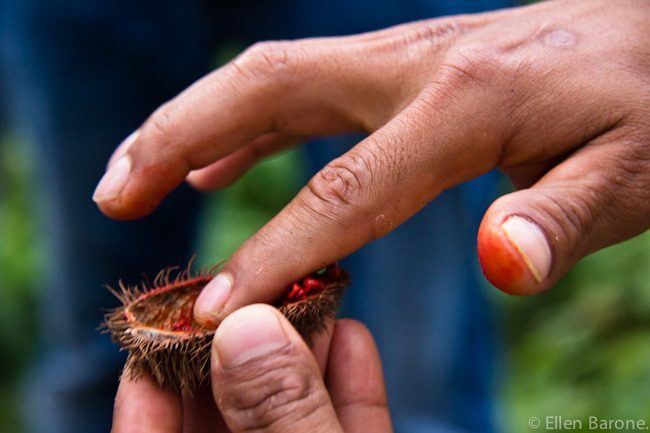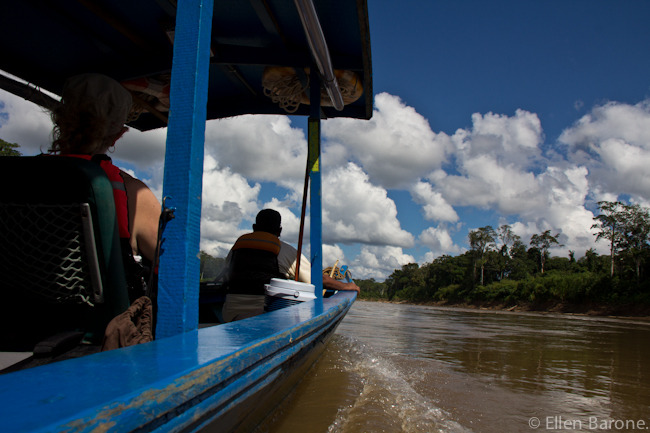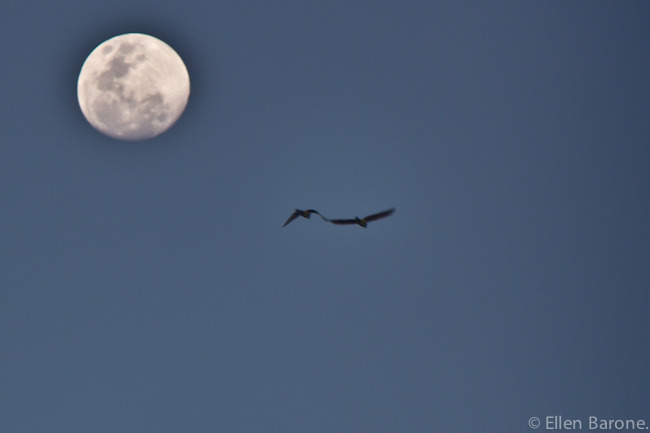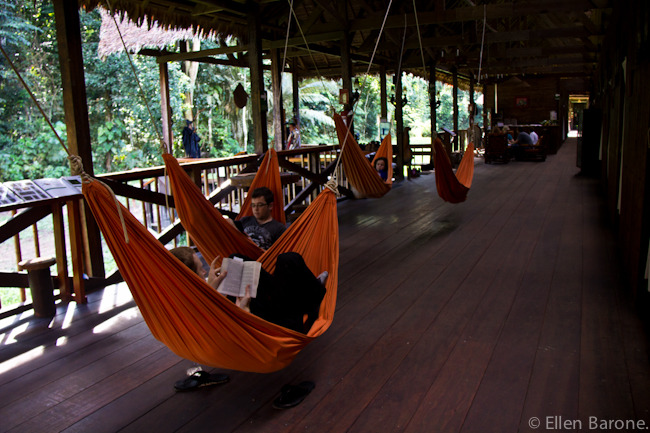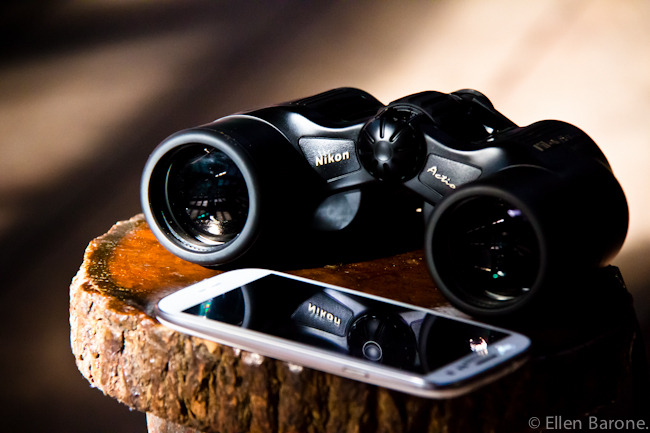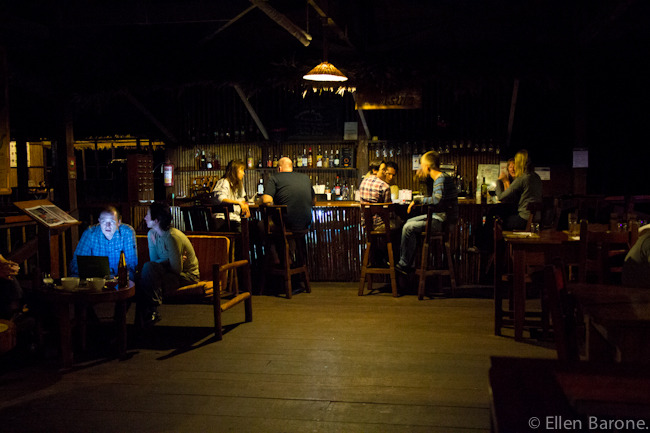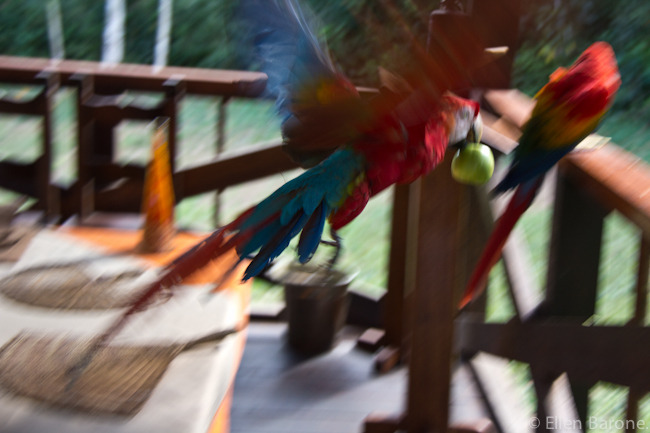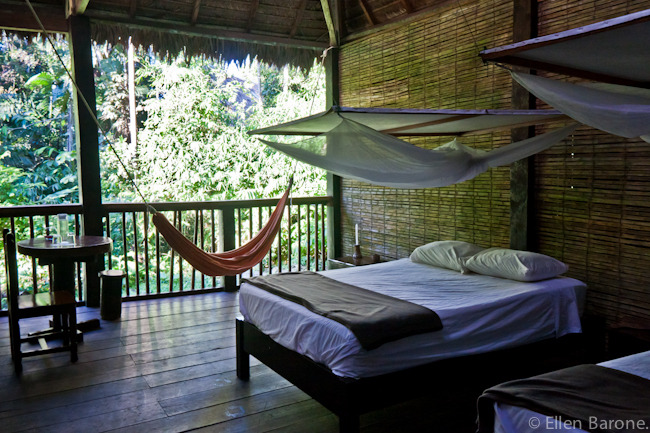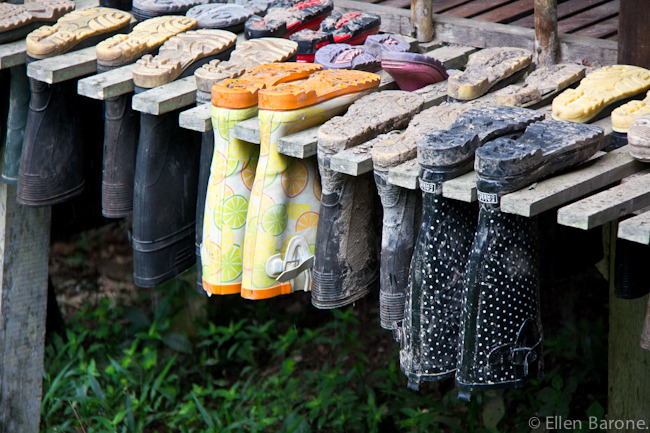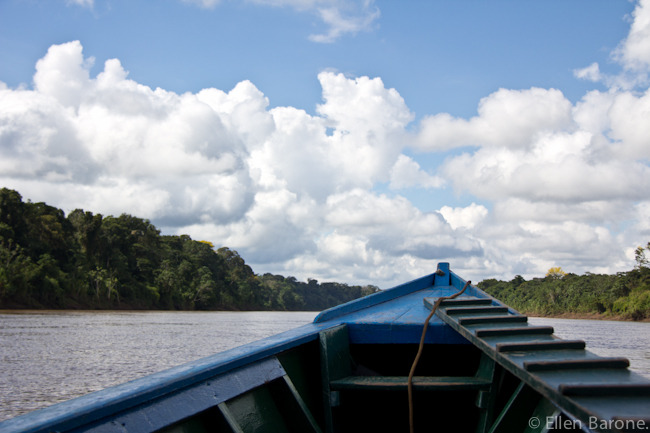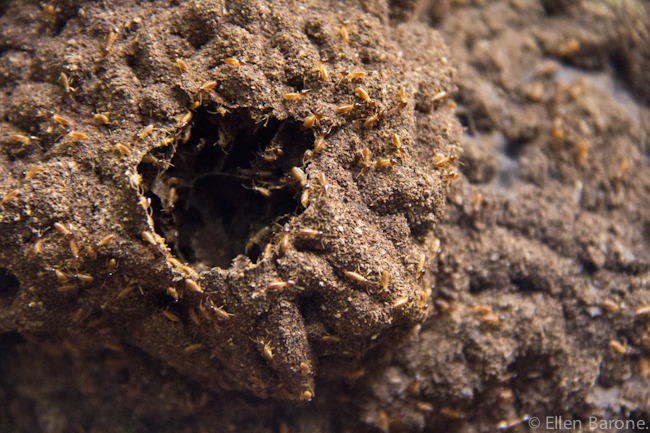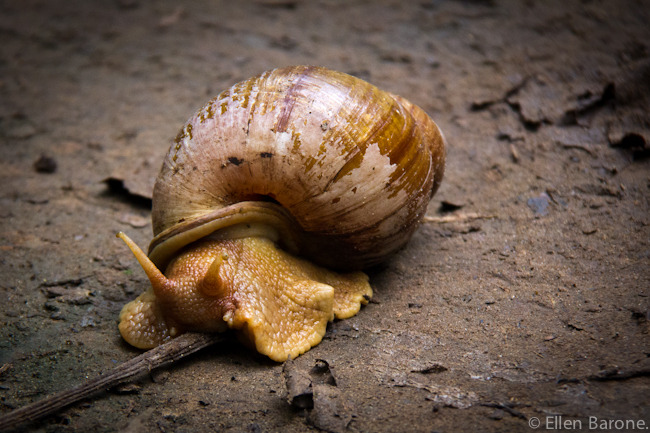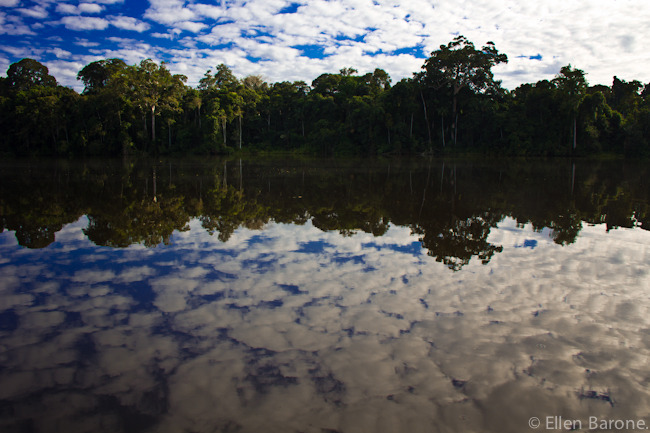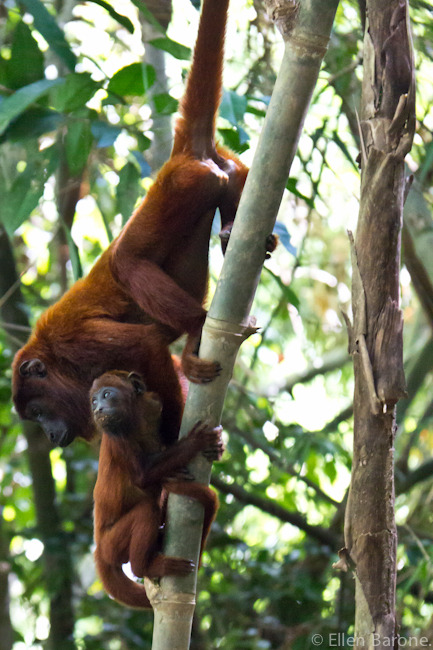It was 4AM. The kerosene lanterns used to illuminate our open-air room flickered to life, a subtle reminder to get moving. I crawled out from under the mosquito netting, shuffled down the hall to the communal bathrooms and fifteen minutes later was tromping down a dark jungle trail in mud boots and a headlamp to board a boat.
Groggy and grumpy, I wished I’d stayed in bed as the motorized canoe puttered upriver in damp obscurity to deliver us to the sandy islet that would serve as our birding blind. The sky was still ink black as we settled in to wait. Perched upon folding canvas campstools we clutched cameras and tin cups of tea in anticipation of the morning’s Big Event –the world’s largest macaw claylick.
Soon, an iridescent sunrise painted the canopy treetops and steep cliffside a dazzling ruby red, casting shimmering reflections in the muddy river below. Not long afterwards, pairs of blue-and-gold and scarlet macaws started circling overhead, squawking their boisterous arrival. Catching the luminous sun beneath their wings, the huge, flamboyant parrots flashed blazing glimpses of yellow and crimson as they swooped in to eat the mineral-rich clay soil they need to stay healthy.
How could I have ever thought of sleeping in? This was Pachamama (Mother Earth) in fiery surround sound splendor.
That’s the thing about wild places: one minute you’re cursing Mother Nature, the next you’re blown away by her genius.
It was exactly this untamed wildness that had brought my husband, Hank, and me to the Peruvian Amazon, one of the planet’s last frontiers. Also why we elected to travel with Peruvian outfitter, Rainforest Expeditions, a company that is leading the way in community-based ecotourism, environmental education, research and conservation.
Peru’s Tambopata–Candamo Reserved Zone, within which Rainforest Expeditions’ three eco-lodges are situated, comprises 1.5 million hectares (an area larger than the state of Connecticut) of pristine, undisturbed, rainforest and is said to contain the greatest biodiversity of any place on earth.
GETTING STARTED
From the ancient Inca city of Cusco, gateway to Machu Picchu, we hopped a short 45-minute flight to the jungle outpost of Puerto Maldonado, where the adventure begins.
After an airport pickup and a stop at Rainforest Expeditions headquarters, a 45-minute bus ride to the Tambopata River and an hour-long boat trip delivered us to the Posada Amazonas lodge. The spacious thatched-roof lodge is owned by and located within a communal reserve of the indigenous Ese’eja tribe and managed under an innovative joint venture with Rainforest Expeditions.
Between complimentary guided nature walks and jungle excursions, at Posada Amazonas we eased into the adventure. The limited-electricity lodge features a large dining room, common area and wellness center, with 30 open-air guest rooms, each with beds under mosquito nets, private bath and hot water showers (a jungle luxury, we would discover).
TAMBOPATA NATIONAL RESERVE
The next day, we waved goodbye to Posada Amazonas’ creature comforts to make the six-and-a-half hour boat ride (the only access) deep into one of Peru’s remotest territories, the 700,000-hectare Tambopata National Reserve.
The voyage passed in companionable silence, each of us alone with our thoughts as a tropical landscape of towering kapok trees, fluttering butterflies, sandy beaches and fluffy white clouds against a fierce blue-sky, glided by. Along the way we nibbled on snacks of Amazon bananas, oranges and Brazil nuts and enjoyed a delicious lunch of vegetables and rice wrapped in a jungle-friendly bijao leaf and tied with vine. Thanks to Delford, our eagle-eyed guide, we also spotted capybara (gigantic rodents) and caiman (a relative of the alligator) along the riverbank.
Our destination, the Tambopata Research Center (TRC), a smaller, more rustic version of Posada Amazonas, was founded in 1989 and began hosting eco tourists alongside scientists and researchers in 1992 to help fund the fieldwork and educate adventurous visitors.
Less than twenty-percent of Rainforest Expeditions guests make the trip to TRC, so the adventurous few that come to stay at the remote 18-room lodge are there, like us, hoping to see the boisterous flocks of macaws and raucous monkey troops that live there.
Much of our four days at TRC was spent peering up towering ironwood, kapok and strangler fig trees for elusive wildlife and sloshing along muddy trails in rubber boots as we learned about medicinal plants and animal behavior. We spotted toucans and monkeys and spied on the secret lives of smelly peccaries and gigantic tarantulas by flashlight on night walks. We also met a few of the chicos, nine semi-wild macaws that early on in the research project TRC scientists rescued and raised at the station. They live in the wild, but many still return to grab a snack from the fruit basket, or your breakfast roll if you’re not paying attention. What we didn’t do was spot a jaguar, though we did see evidence of the elusive cat in the form of a fresh footprint.
An Amazon adventure isn’t for everyone. There are mosquitoes and mud, heat and humidity, not to mention lethal plants, insects and animals to contend with. But there are also long lazy naps in the hammock, thunderous rainstorms and the sweet smell of Mother Earth. And for those who slow down long enough to notice, an exquisite macro world of fungi, ants and butterflies. The jungle is soft and steamy, otherworldly and exotic in a manner so far removed from ordinary life it feels almost magical.
THE FINALE
There’s something about remote places, where ordinary routines and distractions become vague, distant memories, that restores in me a childlike lightheartedness and fascination with the natural world. There’s time to sit, for example, and watch foraging leaf-cutter ants parade along the rainforest floor carrying leaf sections above their heads, like oversized umbrellas. Or, paint my face bright red with the liquid center of an achiote pod, as we did while touring a local jungle farm.
By the time we’d motored the three-and-a-half hours downriver from TRC to spend our final night at Refugio Amazonas, the third of Rainforest Expeditions’ eco lodges, I’d grown accustomed to the rainforest. I applied insect repellent as part of my morning ablutions as automatically as I brushed my teeth, and could now sleep without one eye cracked beneath mosquito netting in a room open to the forest noises and creatures. I barely noticed my muddy shoes or that my clothes were forever damp.
But I had not yet grown accustomed to cold showers. No matter how hot and steamy I got, stepping beneath that frigid stream of water took my breath away. Settling into our room at Refugio Amazonas my heart soared when I spotted two knobs in the shower. “We have hot water!” I called out to Hank. “I know. I just saw the hot water heater attached to the bathroom wall,” he called back.
Two weeks earlier when we were booking the trip, Hank had pointed out to me that not all the lodges had hot water. “Who needs hot water in the jungle?” I’d said. “A cold shower will be refreshing.” As I stripped off my filthy clothes and stepped into the shower eager with anticipation, I recalled the conversation and my blithe dismissal. The shock of cold hit me just as Hank said, “But it may not work yet. Delford told me that they’re still installing the units.”
Packing Essentials
1. Flashlight and headlamp: Essential for navigating (or reading) at night.
2. Binoculars: Most of the action happens at treetop level.
3. Insect repellent: In addition to wearing long sleeves and pants for protection.
4. Quick-dry clothing: Enough to alternate days, nothing dries quickly in the jungle.
5. Extra batteries and memory cards: With limited electricity recharging or downloading isn’t always an option.
6. Dry bag or waterproof daypack and moisture-absorbing silica gel packs: It rains - a lot - in the Amazon.
7. Something to read: Backlit electronic readers work great, but recharging can be a challenge.
8. Backup medications and eyeglasses: You’re miles from civilization, so don’t risk it.
What’s included?
Programs include all meals, accommodations and guided excursions, river transport and airport (Puerto Maldonado) transfer.
About Rainforest Expeditions
Rainforest Expeditions is a Peruvian ecotourism company that shares with visitors in a sustainable manner and is helping to protect some of the last untouched lowland and premontane tropical humid forests in the Amazon. Since 1989, guests have added value to the region’s standing tropical rainforest. A sensitively conceived and managed (in some cases by native communities) touristic infrastructure creates a competitive alternative to such unsustainable economic uses as clear cutting the forest for timber or for cattle grazing. Rainforest Expeditions has been verified and certified “a sustainable tourism business” by the Rainforest Alliance. For information, booking and rates, visit www.perunature.com.



